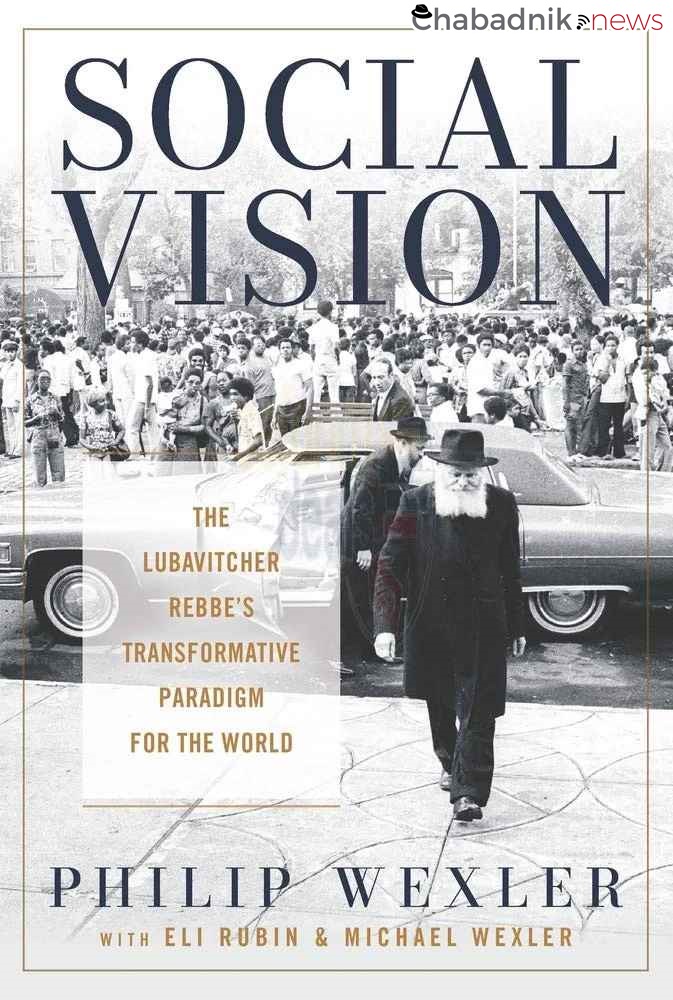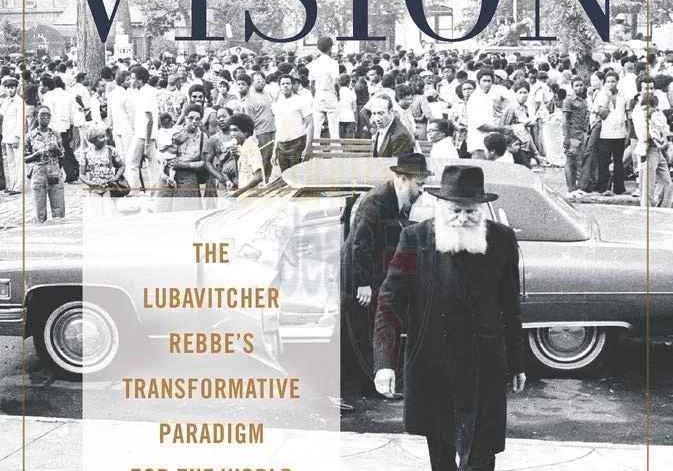Revisiting Social Vision: The Lubavitcher Rebbe’s Transformative Paradigm for the World, by Philip Wexler with Eli Rubin and Michael Wexler

The 11th day of the Hebrew month of Nissan, corresponding this year to Tuesday, April 12, is the 120 anniversary of the birth of the Rebbe—Rabbi Menachem M. Schneerson, of righteous memory. As the day approaches, we are republishing this review article, first published in 2019, which reassesses the social dimensions of the Rebbe’s vision and legacy and argues that perhaps it is only now that we have “eyes to see and ears to hear” his transformative message.
The truth is, when I first stood there listening to the Rebbe speak about the American educational system, penitentiaries and other broad social issues, something wasn’t resonating. Yes, it was neat to hear a Chassidic rabbi thinking outside of the rabbinical “Is it good for the Jews?” straitjacket, genuinely concerned for the rest of the human life on the planet. But as a 20-year-old coming from a typical Jewish liberal background with my history of activism in public protest and far-left politics, I was lost. I couldn’t really say the Rebbe was too far to the right—or to the left. He was nowhere that I could place him. It was simply that this was not what I was looking for.
What was I looking for? The Rebbe’s metaphysics, the deep Chassidic-Kabbalistic talks, the practical and sensitive wisdom, as well as the truly radical take-it-to-the-street campaigns for Jewish observance. But this talk of a more wholesome educational system and criminal sentencing reform seemed like a pedestrian distraction from the transformative spiritual vision the world really needed.
Now Philip Wexler, a well-published American sociologist, has done a great service for people such as myself. His latest book, Social Vision: The Lubavitcher Rebbe’s Transformative Paradigm for the World (Herder and Herder, July 2019), pinpoints what I was missing: First, that the Rebbe was speaking in the 21st century and I was in the 20th. Second, that his positions on down-to-earth social issues were deeply informed by that same up-in-heaven metaphysics I found so fascinating. Now we’re back in radical territory. But perhaps most importantly, Wexler makes it clear that unlike me and my friends, the Rebbe’s goal was to actually get something done.
And he did. The final chapters (5-6) of Social Vision tell the stories of the Rebbe’s initiative to transform public education, to introduce a moment of silence in public schools, to humanize criminal sentencing, and to encourage investment in the research, development and adoption of renewable energy technologies. Wexler, having lectured and published on sociology and education since the mid 1970s, is in a front-row seat to describe the challenges the Rebbe faced, the genius behind the Rebbe’s position, and the impact of the Rebbe’s words.
For one thing, he clearly demonstrates that President Jimmy Carter’s bold and still-controversial endorsement of a federal Department of Education was directly correlated with the Rebbe’s insistence that this was the only way to truly prioritize and revitalize education in America. (Only three days later, Carter signed a proclamation establishing “Education Day” on the day of the Rebbe’s birthday.) The Rebbe’s letter to President Ronald Reagan recommending a “moment of silence” at the beginning of the day in public school was certainly heard, and even implemented in several states—and it continues to be implemented in more schools today. Straight lines are often long lines, and Wexler draws a very solid one from the Rebbe’s talks concerning the American penitentiary system to the passing of the First Step Act just this past December.
The Re-Enchantment of America—and the World
But there’s a reason those chapters are near the end of the book. It’s the context of these initiatives within the Rebbe’s broader conception of society in the book’s opening chapters that provides that truly radical flavor I was missing four decades ago. Here, with the co-authorship of Chabad.org’s Eli Rubin, the book reaches beyond narrative and opens a new door for what Jonathan Garb of Hebrew University calls in his acclamation of Social Vision “prophetic sociology.” In other words, the tools to go beyond predicting the future—to envision a completely different future and actually make it happen.
Most crucially, Wexler asks, “What did the Rebbe want?” What did he want from America, from its government and from its people? What did he want from human society as a whole?
His answer returns consistently to a paradigm supplied by phenomenologist Anthony Steinbok. Steinbok describes how our society has flattened its human dimension to a horizontal plane of the material realm, a plane on which the only measure for us to gauge our own worth and the worth of our endeavors is utility. The vertical dimension of inner meaning and purpose is ignored, even denied.
The Rebbe wanted that back. In Wexler’s words, “Schneerson wanted to reenchant the world. He wanted to reenchant and resacralize the everyday experiences, practices and interactions of all people, everywhere.”
Max Weber’s New Prophet
And not simply as society’s window dressing. The Rebbe believed that the basic functions of society cannot endure without that inner soul. Because in a flat world there is no room for a human being to stand with dignity or appreciate the dignity of another. Indeed, in a utilitarian world, nothing is of value other than its worth to achieve something else.
With a stroke of panoramic vision, Wexler places this “revitalization through re-enchantment,” as well, within a larger context. At the book’s opening, we get a crash course in the basics of a founding father of sociology, Max Weber. In 1905, Weber published one of the most influential and enduring works of the field, The Protestant Ethic and the Spirit of Capitalism. Weber had witnessed firsthand the industrialization of the German lands, hand in hand with the rapid transformation of German society into one whose major concern was the flow of labor and the accumulation of material goods. He asked basic questions: Why had the industrial revolution occurred when it did? And why in Northern Europe and not in China?
Weber placed both credit and blame squarely on what he called “the Protestant work ethic.” Yes, ironically, materialism had its roots in a religious quest for a ticket to the World to Come.
For a Protestant, Weber explained, the only measure that remained to assure himself that he was one blessed and chosen for heaven was success in his “calling in life.” Hard work directed towards material gain thereby became the central focus of life. Eventually, the original religious motivation was lost in the shuffle, and all that was left was a perpetual dynamo of deep-seated anxiety seeking resolution in material gain. In Weber’s own words, what was meant to be a thin cloak became an iron cage.
Weber’s prognosis for this hard-working society motivated by material success was starkly prescient: “No one knows who will live in this cage in the future, or whether at the end of this tremendous development entirely new prophets will arise, or there will be a great rebirth of old ideas and ideals, or, if neither mechanized petrification, embellished with a sort of convulsive self-importance.”
Wexler sees the Rebbe as nothing less than that new prophet of Weber’s musing. The soul of society has expired, leaving the machine running amok without a master. The Rebbe, rather than reviving that old soul, provides an alternative soul—one that will neither weary nor fade. And one that Weber certainly could not have imagined.
The Mystic as an Architect of Society
Weber would certainly have labeled the Rebbe’s cosmology as “mystical,” as opposed to the “ascetic” Protestant who professed no knowledge of any pursuit beyond that which he could see in this world. And Weber saw the mystic as an antisocial recluse. Only begrudgingly did he admit that mystics had at times managed to create societies “despite the apparent demands of logic.”
Wexler’s thesis is that Weber was wrong. Not only can a mystic be part of society, but a certain kind of mysticism, such as the Rebbe espouses, is vital to a society that will respect the dignity of life and the preciousness of this world. And he sees a real possibility that American society will slowly come to adopt this new soul as their own.
I know that sounds preposterous. The Rebbe was not exactly the model of your American personality star. He kept strictly to Orthodox halachah, held tightly to tradition and embraced the particularity of the Jewish people. But, as I’ve argued elsewhere, it’s just that authenticity and those deep roots that provide the credibility, robustness and impetus such a paradigm shift demands. To quote a Chassidic dictum, “To give life you have to be alive yourself.” So, too, to provide a new identity to society you have to know very well who you are.
The truth is, the Rebbe himself would not have called himself a mystic. In a letter to a 1981 conference on Jewish mysticism in London, the Rebbe explained that the job of the true student of Chabad is to make the mystical accessible to human reason and yet further, to the point that “G‑d can be better comprehended by action than by meditation.” Rather, the Rebbe’s approach—which is really the Chabad approach taken all the way—is an exquisite paradox of the mystical and the rational in harmony, the ideal combination for dealing with the paradox of life on Planet Earth.
The Rebbe’s Social Vision of Crime and Sentencing
Social Vision provides plenty of examples in which this mystical-rational approach illuminates our way in modern social issues. The most vivid example in my mind is the Rebbe’s opposition to incarceration as a consequence of crime.
When the Rebbe began campaigning on this issue in 1976, his view could not have been less popular. Crime was steadily rising in America. He addressed the issue most sharply in 1981, when new legislation was introduced to provide stiff sentences for even non-violent crimes. “Law and order” was an essential plank to any platform in American elections.
Since then, America’s incarcerated population has grown by 500 percent to 2.2 million human beings. With a 65 percent recidivism rate, we’re feeling the grand failure of that legislation. Indeed, our prisons are not reducing crime, but actually fueling it while severely marring the futures of the criminal and his entire family.
What was behind the Rebbe’s opposition to incarceration? Social Vision juxtaposes these words of the Rebbe against the ethics of utilitarianism by which a person forfeits his personhood as a consequence of his crime against society:
They know of only one world, [namely] this world that we presently inhabit … As a result, when a person sins, infringing and straying from the path, and causes damage and spoilage to the world—the only world that exists—they arrest him and incarcerate him, isolated in prison, so that he can no longer damage and spoil the world. And even though the freedom that is required for him to fulfill his purpose is thereby withdrawn—such that thereby … he becomes dehumanized—nevertheless this is [considered] inexorable, with no alternative way to prevent damage and spoilage being caused to the majority … The majority supersedes the individual and the individual is inexorably forfeit for the good of the majority.
But according to Torah, in contrast—which is called “Torah of life” (in the daily prayer liturgy) and “Torah of kindness” (Proverbs, 31:26), which is “good for heaven and good for creatures” (cf. Talmud, Kidushin, 40a)—it is impossible … to forfeit the individual and cause him damage in order to prevent damage to the majority … Torah does not cause damage, and even the punishments prescribed by Torah are not simply for the sake of punishment, but are rather for the sake of repairing the sin. Therefore the punishment of incarceration cannot be entertained, because we thereby deny the perpetrator the possibility of fulfilling his purpose and mission.
In two paragraphs, we have a wealth of wisdom concerning the inner meaning of life. For one, that a human life is of intrinsic value, but not just for the sake of being alive—it is because that life is intrinsically connected to a divine purpose. Removing the capacity to fulfill that purpose can therefore not be justified.
And then, that the individual cannot be sacrificed for the sake of the majority. This arises from a discussion of practical law in the Talmud, but the Rebbe provides here a fresh new application: Incarceration simply for the sake of the protection of society is similarly forbidden.
Finally, that every punishment must be for the sake of repair. Indeed, Social Vision returns repeatedly to this theme in the Rebbe’s world view—the theme of tikkun, whereby the entire occupation of humanity is the repair and perfection of G‑d’s world.
The Rebbe’s Social Vision of Education
Incarceration, to the Rebbe, is the basement where humans land when they fall through the cracks of a dehumanized system. Public school is where it all begins—and therefore the first place to fix. Wexler duly informs us of the Rebbe’s metaphysics of public education, an area in which he himself is well-published and eminently qualified.
In a refreshing turn, Wexler compares the Rebbe’s call for a moment of silence at the beginning of each school day to the current impetus for mindfulness training and other contemplative practices in the public school arena. But the Rebbe was looking for something higher.
Social Vision presents the moment of silence initiative as a kind of essential gap-filler for all the holes of today’s education. It is a politically marketable alternative to daily prayer, but it has the advantage of throwing the ball back into the court of the child and the child’s parents. The child is the one to think his or her own thoughts—the Rebbe was adamant that this was not the school’s job and should not be adopted by them. When the child has a question, “What should I think about?”—leave that to the child’s parents or grandparents. The family has been brought back into the child’s education, along with the child himself.
It’s also a moment for transcendence. There is something beyond literacy and math, something beyond making a living, something beyond all of us. In the Rebbe’s universe, a society cannot survive without a sense of the transcendental. Something beyond reason has been brought back into school.
And from that point on, the Rebbe insists, for the sake of America and for the sake of the world, let the child experience himself as a human soul with a sacred mission in this world. Bring the human conscience back into school. Then there will be no need for that catch-all basement-level prison.
Who Is This Book For?
Social Vision is a book that has something for everybody. For the academic, this is a book to be studied, a new paradigm for a new, post-Weberian and post-postmodern sociology. For the observant Jew, it’s a call to extend one’s vision beyond typical Jewish issues and help fix the entire world. For the yet-unaffiliated Jew, it’s a social vision of what observant Judaism is supposed to look like. For all people, whatever affiliation or nationality, it’s a breath of fresh air—the oxygen to revive and heal the world in which we live.
Yes, in the years from 1950–1992, these words and ideas did not always have fertile ground upon which to fall. The earth had yet to be plowed and softened before the rain. But now we live in a different world. Perhaps now we have eyes to see and ears to hear.
As in the metaphor borrowed by Wexler to describe social change and progress, the chrysalis has grown brittle and flimsy. Within, the gooey remains of a caterpillar hears the call of a new DNA. Composed of the same old cells but rearranged by a different soul, a new creature prepares to witness the light of day.




